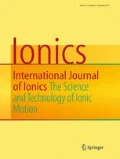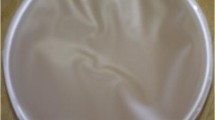Abstract
The development of magnesium electrolytes for battery applications has been the demand for electrochemical devices. To meet such demand, in this work solid blend polymer electrolytes were prepared using polyvinyl alcohol (PVA) and polyacrylonitrile (PAN) (92.5PVA:7.5PAN) as host polymer, magnesium chloride (MgCl2) of different molar mass percentage (m.m.%) (0.1, 0.2, 0.3, 0.4, 0.5, and 0.6%) as salt and dimethylformamide (DMF) as solvent. Structural, vibrational, thermal, electrical, and electrochemical properties of the prepared electrolytes were investigated using different techniques such as X-ray diffraction pattern, FTIR spectroscopy analysis, differential scanning calorimetry (DSC), AC impedance measurement, and transference number measurement. X-ray diffraction studies confirm the minimum volume fraction of crystalline phase for the polymer electrolyte with 0.5 m.m.% of MgCl2. FTIR confirms the complex formation between host polymer and salt. DSC analysis proves the thermal transition of the prepared films are affected by salt concentration. The optimized material with 0.5 m.m.% of MgCl2 offers a maximum electrical conductivity of 1.01 × 10−3 S cm−1 at room temperature. The Mg2+ ion conduction in the blend polymer electrolyte is confirmed from transference number measurement. Electrochemical analysis demonstrates the promising characteristic of these polymer films suitable as electrolytes for primary magnesium batteries. Output potential and discharge characteristics have been analyzed for primary magnesium battery which is constructed using optimized conducting electrolyte.
















Similar content being viewed by others
References
Tarascon JM, Armand M (2001) Issues and challenges facing rechargeable lithium batteries. Nature 414:359–367
Zhang J, Zhao J, Yue L, Wang Q, Chai J, Liu Z et al (2015) Safety-reinforced poly (propylene carbonate)-based all-solid-state polymer electrolyte for ambient-temperature solid polymer lithium batteries. Adv Energy Mater 5(24)
Kaplan ML, Rietman EA, Cava RJ, Holt LK, Chandross EA (1987) Crown ether enhancement of ionic conductivity in a polymer-salt system. Solid State Ionics 25(1):37–40
Roux C, Gorecki W, Sanchez JY, Belorizky E (1998) Various aspects of dynamical properties of high and low molecular weight PPO-LITFSI polymer electrolytes obtained by NMR techniques. Electrochim Acta 43(10):1575–1579
Shukla, P.K. and Agrawal, S.L. (1998) Proceedings of the 6th Asian Conference on Solid State Ionics, New Delhi India
Subban RH, Arof AK (2003) Experimental investigations on PVC-LiCF3SO3-SiO 2 composite polymer electrolytes. J New Mater Electrochem Syst 6(3):197–203
Mohamed NS, Arof AK (2004) Investigation of electrical and electrochemical properties of PVDF-based polymer electrolytes. J Power Sources 132(1):229–234
Stephan AM, Thirunakaran R, Renganathan NG, Sundaram V, Pitchumani S, Muniyandi N, Gangadharan R, Ramamoorthy P (1999) A study on polymer blend electrolyte based on PVC/PMMA with lithium salt. J Power Sources 81:752–758
Morales E, Acosta JL (1997) Thermal and electrical characterization of plasticized polymer electrolytes based on polyethers and polyphosphazene blends. Solid State Ionics 96(1–2):99–106
Ulaganathan M, Mathew CM, Rajendran S (2013) Highly porous lithium-ion conducting solvent-free poly (vinylidene fluoride-co-hexafluoropropylene)/poly (ethyl methacrylate) based polymer blend electrolytes for Li battery applications. Electrochim Acta 93:230–235
Rajendran S, Sivakumar M, Subadevi R (2004) Investigations on the effect of various plasticizers in PVA–PMMA solid polymer blend electrolytes. Mater Lett 58(5):641–649
Reddy CVS, Sharma AK, Rao VN (2002) Effect of plasticizer on electrical conductivity and cell parameters of PVP+ PVA+ KClO 3 blend polymer electrolyte system. J Power Sources 111(2):357–360
Subramania A, Kalyana Sundaram NT, Vijaya Kumar G, Vasudevan T (2006) New polymer electrolyte based on (PVA–PAN) blend for li-ion battery applications. Ionics 12:175–178
Rudhziah S, Mohamed NS (2009) Characterization of proton conducting PVDF-HFP/PEMA blend based solid electrolytes. Solid State Sci Technol 17(1):73–80
Lee JH, Lee HB, Andrade JD (1995) Blood compatibility of polyethylene oxide surfaces. Prog Polym Sci 20(6):1043–1079
Robeson LM, Hale WF, Merriam CN (1981) Miscibility of the poly (hydroxy ether) of bisphenol A with water-soluble polyethers. Macromolecules 14(6):1644–1650
Song JY, Wang YY, Wan CC (1999) Review of gel-type polymer electrolytes for lithium-ion batteries. J Power Sources 77(2):183–197
Sivadevi S, Selvasekarapandian S, Karthikeyan S, Vijaya N, Kingslin Mary Genova F, Sanjeeviraja C (2013) Structural and AC impedance analysis of blend polymer electrolyte based on PVA and PAN. Int J Sci Res 2(10)
Vignarooban K, Kushagra R, Elango A, Badami P, Mellander BE, Xu X, Tucker TN, C., & Kannan, A. M. (2016) Current trends and future challenges of electrolytes for sodium-ion batteries. Int J Hydrog Energy 41(4):2829–2846
Ramaswamy M, Malayandi T, Subramanian S, Srinivasalu J, Rangaswamy M (2017) Magnesium ion conducting polyvinyl alcohol–polyvinyl pyrrolidone-based blend polymer electrolyte. Ionics 23(7):1771–1781
Sundar M, Selladurai S (2006) Effect of fillers on magnesium–poly (ethylene oxide) solid polymer electrolyte. Ionics 12(4–5):281–286
Pandey GP, Hashmi SA (2009) Experimental investigations of an ionic-liquid-based, magnesium ion conducting, polymer gel electrolyte. J Power Sources 187(2):627–634
Sivadevi S, Selvasekarapandian S, Karthikeyan S, Vijaya N, Kingslin F, Genova, Sanjeeviraja C, Nithya H & Kawamura IJ (2013) Proton-conducting polymer electrolyte based on PVA-PAN blend polymer doped with NH4NO3. Int J Electroact Mater (1), 64–70
Sivadevi S, Selvasekarapandian S, Karthikeyan S, Sanjeeviraja C, Nithya H, Iwai Y, Kawamura J (2014) Proton-conducting polymer electrolyte based on PVA-PAN blend doped with ammonium thiocyanate. Ionics (21):1017-1029
Kingslin Mary Genova F, Selvasekarapandian S, Karthikeyan S, Vijaya N, Pradeepa R, Sivadevi S (2015) Study on blend polymer (PVA_PAN) doped with lithium bromide. Polymer Sci 57:851–862
Francis KMG, Subramanian S, Shunmugavel K, Naranappa V, Pandian SSM, Nadar SC (2016) Lithium ion-conducting blend polymer electrolyte based on PVA–PAN doped with lithium nitrate. Polym-Plast Technol Eng 55(1):25–35
Mohamoud MA, Hillman AR (2007) The effect of anion identity on the viscoelastic properties of polyaniline films during electrochemical film deposition and redox cycling. Electrochim Acta 53(3):1206–1216
Hashmi SA, Chandra S (1995) Experimental investigations on a sodium-ion-conducting polymer electrolyte based on poly (ethylene oxide) complexed with NaPF6. Mater Sci Eng B 34(1):18–26
Evans J, Vincent CA, Bruce PG (1987) Electrochemical measurement of transference numbers in polymer electrolytes. Polymer 28(13):2324–2328
Agrawal RC, Hashmi SA, Pandey GP (2007) Electrochemical cell performance studies on all-solid-state battery using nano-composite polymer electrolyte membrane. Ionics 13(5):295–298
Sridevi D, Rajendran KV (2009) Synthesis and optical characteristics of ZnO nanocrystals. Bull Mater Sci 32(2)
Hodge RM, Edward GH, Simon GP (1996) Water absorption and states of water in semicrystalline poly (vinyl alcohol) films. Polymer 37(8):1371–1376
Baskaran R, Selvasekarapandian S, Kuwata N, Kawamura J, Hattori T (2006) Conductivity and thermal studies of blend polymer electrolytes based on PVAc–PMMA. Solid State Ionics 177(26):2679–2682
Novák P, Imhof R, Haas O (1999) Magnesium insertion electrodes for rechargeable nonaqueous batteries—a competitive alternative to lithium? Electrochimica Acta 45(1):351–367
Abdelaziz M, Abdelrazek EM (2007) Effect of dopant mixture on structural, optical and electron spin resonance properties of polyvinyl alcohol. Physica B: Condensed Matter 390(1):1–9
Wu KH, Wang YR, Hwu WH (2003) FTIR and TGA studies of poly (4-vinylpyridine-co-divinylbenzene)–Cu (II) complex. Polym Degrad Stab 79(2):195–200
Laot CM, Marand E, Oyama HT (1999) Spectroscopic characterization of molecular interdiffusion at a poly (vinyl pyrrolidone)/vinyl ester interface. Polymer 40(5):1095–1108
Li X, Goh SH, Lai YH, Wee ATS (2000) Miscibility of carboxyl-containing polysiloxane/poly (vinylpyridine) blends. Polymer 41(17):6563–6571
Stupp SI, Carr SH (1977) Chemical origin of thermally stimulated discharge currents in polyacrylonitrile. J Polym Sci B Polym Phys 15(3):485–499
Coleman MM, Petcavich RJ (1978) Fourier transform infrared studies on the thermal degradation of polyacrylonitrile. J Polym Sci B Polym Phys 16(5):821–832
Pandey GP, Agrawal RC, Hashmi SA (2011) Magnesium ion-conducting gel polymer electrolytes dispersed with fumed silica for rechargeable magnesium battery application. J Solid State Electrochem 15(10):2253–2264
Chen HW, Xu H, Huang CF, Chang FC (2004) Novel polymer electrolyte composed of poly (ethylene oxide), lithium triflate, and benzimidazole. J Appl Polym Sci 91(2):719–725
Su'ait MS, Ahmad A, Badri KH, Mohamed NS, Rahman MYA, Ricardo CA, Scardi P (2014) The potential of polyurethane bio-based solid polymer electrolyte for photoelectrochemical cell application. Int J Hydrogen Energy 39(6):3005–3017
Koenig J L 1999 Spectroscopy of polymers (Amsterdam:Elsevier) 2nd ed
Pavia D L, Lampman G M and Kriz G S (2001) Introduction to spectroscopy (Fort Worth: Harcourt College Publishers) 3rd ed
MacCallum JR, & Vincent CA (Eds.). (1989) Polymer electrolyte reviews (Vol. 2). Springer Science & Business Media
Manjuladevi R, Thamilselvan M, Selvasekarapandian S, Mangalam R, Premalatha M, Monisha S (2017) Mg-ion conducting blend polymer electrolyte based on poly (vinyl alcohol)-poly (acrylonitrile) with magnesium perchlorate. Solid State Ionics 308:90–100
Flora XH, Ulaganathan M, Rajendran S (2012) Influence of lithium salt concentration on PAN-PMMA blend polymer electrolytes. Int J Electrochem Sci 7:7451–7462
Lanfredi S, Saia PS, Lebullenger R, Hernandes AC (2002) Electric conductivity and relaxation in fluoride, fluorophosphate and phosphate glasses: analysis by impedance spectroscopy. Solid State Ionics 146(3):329–339
Mishra R, Baskaran N, Ramakrishnan PA, Rao KJ (1998) Lithium ion conduction in extreme polymer in salt regime. Solid State Ionics 112(3):261–273
Boukamp BA (1986) A nonlinear least squares fit procedure for analysis of immittance data of electrochemical systems. Solid State Ionics 20(1):31–44
Boukamp BA (1986) A package for impedance/admittance data analysis. Solid State Ionics 18:136–140
Aziz SB (2013) Li+ ion conduction mechanism in poly (ε-caprolactone)-based polymer electrolyte. Iran Polym J 22(12):877–883
Lim YJ, An YH, Jo NJ (2012) Polystyrene-Al 2 O 3 composite solid polymer electrolyte for lithium secondary battery. Nanoscale Res Lett 7(1):19
Ramya CS, Selvasekarapandian S, Savitha T, Hirankumar G, Baskaran R, Bhuvaneswari MS, Angelo PC (2006) Conductivity and thermal behavior of proton conducting polymer electrolyte based on poly (N-vinyl pyrrolidone). Eur Polym J 42(10):2672–2677
Druger SD, Ratner MA, Nitzan A (1986) Applications of dynamic bond percolation theory to the dielectric response of polymer electrolytes. Solid State Ionics 18:106–111
Ramesh S, Arof AK (2001) Ionic conductivity studies of plasticized poly (vinyl chloride) polymer electrolytes. Mater Sci Eng B 85(1):11–15
J.R. Mac Callum, C.A. Vincent (1989). Low frequency dielectric properties of polyether electrolytes. Elsevier Appl. Sci. 43–60
Macdonald JR (ed) (1987) Impedance spectroscopy. Wiley
Kyritsis A, Pissis P, Grammatikakis J (1995) Dielectric relaxation spectroscopy in poly (hydroxyethyl acrylates)/water hydrogels. J Polym Sci B Polym Phys 33(12):1737–1750
Adachi K, Urakawa O (2002) Dielectric study of concentration fluctuations in concentrated polymer solutions. J Non-Cryst Solids 307:667–670
Shastry MCR, Rao KJ (1991) Ac conductivity and dielectric relaxation studies in AgI-based fast ion conducting glasses. Solid State Ionics 44(3–4):187–198
Kumar Y, Hashmi SA, Pandey GP (2011) Ionic liquid mediated magnesium ion conduction in poly (ethylene oxide) based polymer electrolyte. Electrochim Acta 56(11):3864–3873
Abraham KM, Jiang Z, Carroll B (1997) Highly conductive PEO-like polymer electrolytes. Chem Mater 9(9):1978–1988
Kumar GG, Munichandraiah N (2002) Poly (methylmethacrylate)—magnesium triflate gel polymer electrolyte for solid state magnesium battery application. Electrochim Acta 47(7):1013–1022
Pandey GP, Agrawal RC, Hashmi SA (2011) Performance studies on composite gel polymer electrolytes for rechargeable magnesium battery application. J Phys Chem Solids 72(12):1408–1413
Rosdi A, Zainol NH, & Osman Z (2016) Ionic transport and electrochemical stability of PVDF-HFP based gel polymer electrolytes. In AIP Conference Proceedings (Vol. 1711, No. 1, p. 050003). AIP Publishing
Kumar GG, Munichandraiah N (2000) Solid-state Mg/MnO 2 cell employing a gel polymer electrolyte of magnesium triflate. J Power Sources 91(2):157–160
Kadir MFZ, Majid SR, Arof AK (2010) Plasticized-chitosan-PVA blend polymer electrolyte based proton battery. Electrochimca Acta 55:1475–1482
Reddy CVS, Sharma AK, Rao VN (2003) Conductivity and discharge characteristics of polyblend (PVP+ PVA+ KIO 3) electrolyte. J Power Sources 114(2):338–345
Author information
Authors and Affiliations
Corresponding author
Rights and permissions
About this article
Cite this article
Manjuladevi, R., Thamilselvan, M., Selvasekarapandian, S. et al. Preparation and characterization of blend polymer electrolyte film based on poly(vinyl alcohol)-poly(acrylonitrile)/MgCl2 for energy storage devices. Ionics 24, 1083–1095 (2018). https://doi.org/10.1007/s11581-017-2273-9
Received:
Revised:
Accepted:
Published:
Issue Date:
DOI: https://doi.org/10.1007/s11581-017-2273-9




